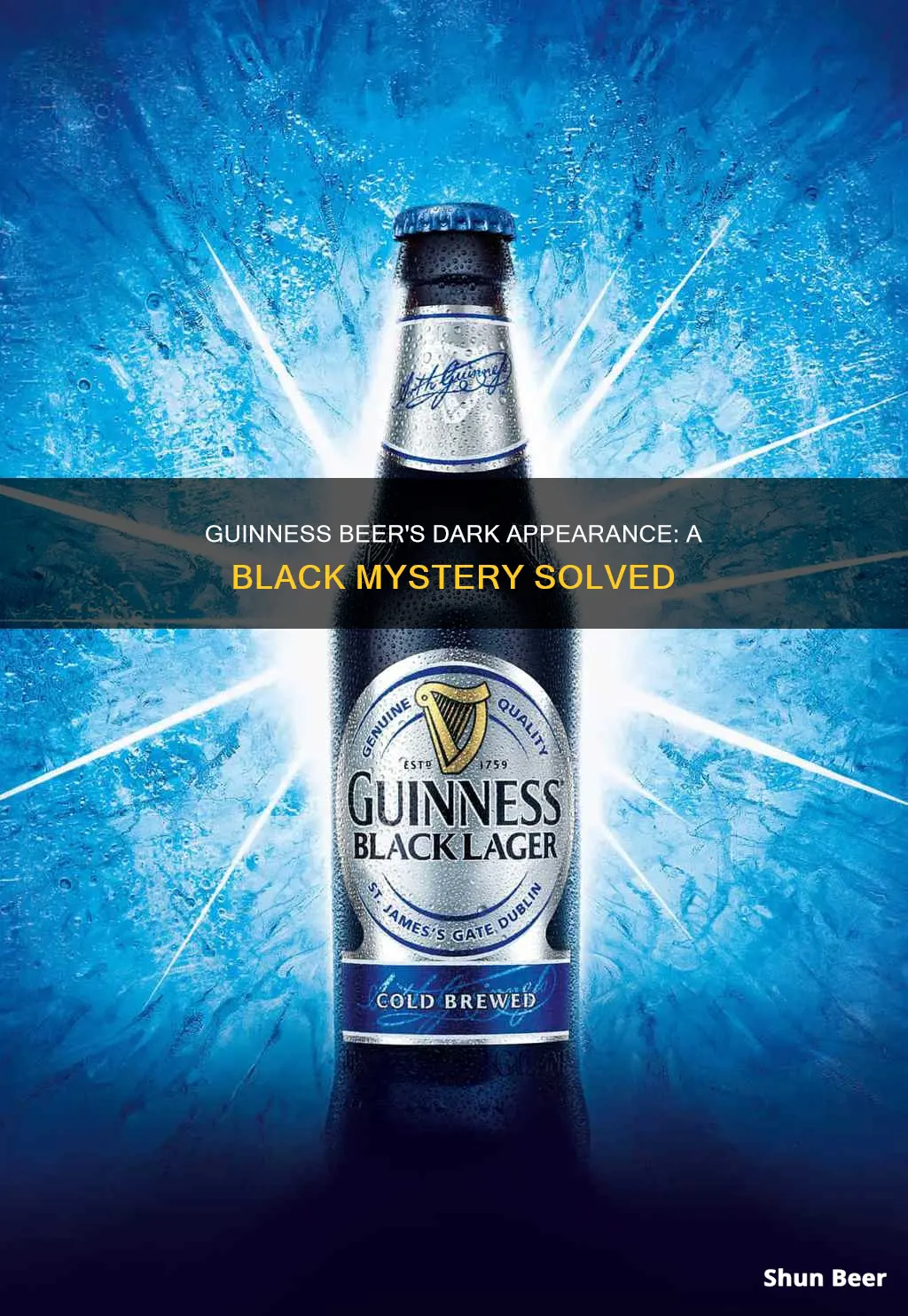
The distinctive black colour of Guinness beer is due to the roasting process that its barley undergoes. The barley is roasted to a rich black finish at exactly 232 degrees Celsius. However, despite appearances, Guinness is not actually black but a dark ruby red. The company has referred to it as 'the black stuff' in marketing materials, but it is also officially referred to as a very dark shade of ruby.
What You'll Learn

Roasted barley
The black colour of Guinness stout is due to the roasted barley used in its production. The barley is roasted to a rich black finish at exactly 232 degrees Celsius. This roasting process brings out the flavours, aromas, and colours that make Guinness a perfect example of Irish stout. However, despite the black appearance of the roasted barley, Guinness is not considered to be truly black, but rather a very dark shade of ruby.
The process of roasting the barley involves partially germinating the barley in water and then drying it with hot air. This step is crucial in developing the distinct flavours and colours of Guinness. The barley is sourced from local farmers, some of whom have been supplying the brewery for generations. After roasting, the barley is used to create a perfumed blend of malted, roasted, and flaked barley, which forms the foundation of the mashing, fermentation, and brewing processes that follow.
Guinness stout has a unique appearance, with a thick, creamy head that is achieved by mixing the beer with nitrogen and carbon dioxide. The use of nitrogen also contributes to the smooth and creamy texture of the beer, as nitrogen bubbles are much smaller than carbon dioxide bubbles. This combination of appearance and texture has made Guinness a beloved and iconic drink around the world.
The flavour of Guinness is described as having a balance of bitterness and sweetness, with notes of sweet malt and roasted coffee. This balance, along with its low ABV of around 4.2%, has contributed to the enduring popularity of Guinness. The brand's 200-year-old traditions and mystique also add to its appeal, making it a symbol of Irish pride and culture.
In conclusion, the black colour of Guinness can be attributed to the roasting of barley, a key ingredient in its production. The precise roasting process brings out the distinct characteristics of Guinness, making it one of the most successful alcohol brands worldwide.
Guinness Beer: Kosher Certification and Jewish Drinking Traditions
You may want to see also

Kilning
Firstly, most of the surface moisture of the germinated grain is driven off. In the final stage, the malt is "cured". The goal is to reduce the grain's moisture content from about 40% to 50% down to at least 4% to 6%. The sequencing of the temperature levels is important. If the grain is heated when it is too moist and the temperature is too high, its enzymes will be denatured, rendering it useless for mashing. A typical temperature sequence is: step one at 50°C to 60°C (122°F to 140°F), step two at 65°C to 75°C (149°F to 167°F), and a curing step at 80°C to 105°C (176°F to 221°F).
The kilning process is what gives Guinness its distinctive colour and flavour.
Guinness Beer vs. World Records: What's the Difference?
You may want to see also

Nitrogen and carbon dioxide
Nitrogen is very difficult to dissolve into beer. It requires pressure levels much higher than those typically used to move beer. So when the beer is poured, the nitrogen bubbles quickly dissipate, resulting in lower-level carbonation and a smooth, creamy mouthfeel. This rapid release of nitrogen creates a rising column of bubbles in the centre of the glass, which forces the beer and bubbles along the wall to sink, causing the characteristic cascade.
Breweries typically use carbon dioxide to give beer its quintessential bitter fizz. However, when a drink calls for a sweeter, silkier experience, like Guinness, brewers infuse the ale with nitrogen instead of carbon dioxide. Guinness was the world's first nitro beer. Nitrogen bubbles are smaller than carbon dioxide bubbles, resulting in a smoother, more delicate head and taste.
There are approximately 300 million bubbles in a pint of Guinness, compared to up to 2 million bubbles in a typical lager. Nitrogen bubbles are more stable, so when a beer is opened, more of the tiny bubbles stay intact. This, along with the smaller bubbles, gives Guinness a thicker, more velvety "mouthfeel" without the acidic bite of carbonation with carbon dioxide.
To achieve the desired level of carbonation and the characteristic creamy head of a draught Guinness, a combination of nitrogen and carbon dioxide is used. The draught beer is mixed with nitrogen and carbon dioxide, and then forced through fine holes in a plate in the tap, creating the very small bubbles that give Guinness its unique texture and taste.
Guinness Beer and Caffeine: What's the Connection?
You may want to see also

Not suitable for vegetarians/vegans
Guinness is a dry Irish stout that was originally produced in Dublin, Ireland, and has been brewed for over 260 years. It is now manufactured in five countries and is one of the world's most popular drinks, with 10 million pints consumed daily.
However, until 2016, Guinness was not suitable for vegetarians or vegans due to its manufacturing process. The beer was clarified using isinglass, a substance derived from the dried swim bladders of fish. This traditional method of clarification is common in the production of alcoholic beverages like beer and wine, and it was thought that the public preferred clear, uncloudy beer.
In 2015, Diageo, the company that manufactures Guinness, announced it would be implementing a new filtration system to eliminate isinglass from the manufacturing process, thus making Guinness suitable for vegetarians and vegans. This new filtration process was fully adopted in 2018, and Diageo confirmed that all Guinness products worldwide, including Guinness Draught, Guinness Extra Stout, and Guinness Foreign Extra Stout, are now isinglass-free.
The recipe for Guinness has not changed, and the taste remains the same. Guinness is made from four main ingredients: roasted and malted barley, hops, water, and yeast. The deep ruby red colour and signature foamy white top are achieved through the use of nitrogen and carbon dioxide gas, which create a frothy topping when the beer is poured.
Guinness Beer: Iron-Rich Brew or Just a Myth?
You may want to see also

Not black, but dark ruby red
While Guinness is often referred to as "the black stuff" in marketing, the beer is not actually black. Instead, it is a dark ruby red colour. The distinctive ruby red hue comes from the way the ingredients are prepared. Some raw barley is roasted, in a similar way to coffee beans, which gives Guinness its unique colour.
The roasting process is integral to the flavour and colour of Guinness. The barley is roasted at exactly 232 degrees Celsius, which is the sweet spot for bringing out the flavours, aromas, and colours that make Guinness so distinctive. The intense heat cooks the natural sugars in the barley, turning the grains black. However, the finished stout is not black but a dark ruby red.
The colour of Guinness can be deceiving, as it appears almost painted onto the glass due to the contrast between the dark beer and the light, creamy head. But when held up to the light, the ruby red hue becomes apparent. So, while Guinness is often associated with the colour black, the beer itself is a rich, dark ruby red.
The colour of Guinness is a result of its status as a stout beer. Stouts are created using roasted malted barley, which gives them their characteristic dark colour. The roasting process also affects the flavour, giving Guinness its dry and coffee-like taste. While the colour of a beer is not always an accurate indicator of its taste, stouts like Guinness tend to have a rich and roasty flavour.
In addition to the roasting process, the specific ingredients used in Guinness also contribute to its colour. The key ingredients in Guinness are roasted barley, malted barley, hops, yeast, and water. The combination of these ingredients, along with the roasting process, results in the unique dark ruby red colour of Guinness.
Vegan Alert: Guinness Beer's Surprising Ingredient
You may want to see also
Frequently asked questions
Guinness is a stout beer, which means it is brewed using roasted malted barley, similar to how coffee beans are prepared. The roasting process cooks sugars, amino acids, and grains together, resulting in a very dark colour.
The intense heating process during brewing cooks sugars, amino acids, and grains together, resulting in the dark colour associated with Guinness.
While Guinness has a short ingredient list of malted barley, hops, yeast, and water, the roasting of barley plays a crucial role in achieving its distinct black colour.







